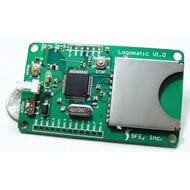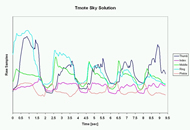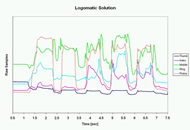Evaluation of an SD Memory Card Datalogger for Portable Long-Term Data Collection
Lisa K. Simone, PhD1 and Brad Galego, BS1
1 New Jersey Institute of Technology, Newark, NJ
ABSTRACT
Researchers are exploring new portable and wearable methods to record biomedical data as individuals participate in home and community activities, and a common challenge is to quickly create inexpensive and wearable measurement systems that can collect a large amount of data. The goal of this work was to evaluate the feasibility of the Logomatic Serial SD Datalogger module to meet these needs. A significant feature of the device is that it uses the familiar SD (Secure Digital) removable memory card for data storage. A prototype device was developed to collect finger flexion data over an extended period of time. Pros and cons of the device for the collection of biomedical data are explored, including cost, weight, time to prototype, and technical specifications.
KEYWORDS:
Wearable monitoring, portable dataloggers, outcome measurements, finger flexion
BACKGROUND/CURRENT METHODS
Many research ideas and hypotheses require a measurement system to collect and record real-time data. Initial prototype work is often performed in a research and development lab using a desktop or laptop computer with a data acquisition card or separate data acquisition instrument. However, many research and clinical goals now include assessing function outside the clinic or evaluating compliance to rehabilitation protocols. To accomplish this, the entire measurement system must be reduced in size, weight and ideally cost, while retaining the capacity to store large amounts of data.
At this stage, researchers are faced with the “make versus buy” decision. One option (“buy”) is to purchase a commercial wearable data acquisition system. While much research is in progress to create such systems (e.g., Lifeshirt from VivoMetrics, the SmartShirt from Sensatex), currently available commercial systems focus on traditional signals such as ECG, heart rate, blood pressure, and pulse oximetry. These are generally restricted to specific sensors and signals and are not expandable to include other inputs. More customized systems allow the collection of biomechanical (e.g., Measureand, Canada) and postural data (e.g., Xsens, The Netherlands), although these tend to be more expensive.
The “buy” option has several advantages. Data collection can begin immediately and the hardware and software have undergone some level of accuracy testing. The investigator need only perform a standard validation that the instrument is performing as specified. Disadvantages are cost and lack of customization. The devices may include more functionality than needed, and supplied software may or may not be useful for the intended application. Two challenges with these systems are data capacity and battery life; many cannot store much data locally and must transmit data using a wireless link to a nearby computer or internet gateway for long term data storage. This is often coupled with lower battery life which limits the maximum duration of a data collection session, or effectively ties the wearer to a radius around the data collection computer.
The second option, “make,” requires that the entire device be created from scratch. The advantage is that the device is customized to the application, with the hardware and software needed to perform the desired functions. Everything from size and color to the exact number of sensors to the placement of mounting holes can be specified. This can be a powerful and cost-effective route if researchers produce a moderate volume of devices or have completed prototyping and established solid requirements for the system. A significant disadvantage is the investment in engineering design knowledge and tools needed to create the device. A second disadvantage is time to availability; the device cannot be used for research until it had been designed, developed, and tested. Often, a second iteration of design is needed. In addition, any changes to the requirements (e.g., adding another sensor input or increasing the size of the data storage memory) could lead to more delays in availability.
Over the last several years, a third option between “make” and “buy” has emerged. The trend toward more plug-and-play hardware and software components has opened the door for the rapid development and deployment of real-time medical data loggers without the expensive and time-consuming design and manufacturing steps. Intuitive companies have recognized the need to create robust data acquisition systems quickly and inexpensively, and many now offer building-block components that allow designers to create new semi-custom systems. This combines the best of the “make” and “buy” options for researchers who wish to explore new ideas quickly without a significant cost investment.
One building-block solution includes a generic data acquisition system based on a standalone data collection box or a PDA (personal digital assistant) device. The PDA acts as the data storage device and controller, and an external data acquisition card or component with sensor inputs is used to acquire the real-time data. Advantages include more portability and lower cost over a laptop-based solution, but the user must wear several components and the entire system may be larger than desired. Some specific sensor modules may be commercially available, but often the research team must design the sensor interface. With these solutions, time-to-prototype and cost are generally lower than for dedicated systems.
A second type of building-block solution involves a customized data collection board or module that is not based on an existing stand-alone product. We have explored this type of solution in the past using the low power Tmote Sky wireless module (Moteiv, San Francisco, CA) to develop a custom wearable system for monitoring hand function after brain injury. [1] The Tmote Sky module provides data collection capabilities using a TI MSP430 microcontroller, eight 12-bit ADCs, and 1 MB memory for data storage for $130. The system meets all of our criteria except large onboard data storage. To collect 24 hour data, we store data locally on the device for up to three hours at a time, but must transmit data to a nearby computer to complete extended data collection trials. In this paper, we have explored a different building-block solution to remove the external laptop computer for true, long term wearability at a low cost.
APPROACH
Several design goals were identified: low cost, light, large memory for data storage, quick prototyping, and ease of programming. These were deemed to be core criteria for a wearable data acquisition system that would facilitate timely research feasibility studies rather than delay them. We selected the Logomatic Datalogger module, shown in Figure 1, from Sparkfun (Boulder CO) to meet these needs. The Logomatic has a small form factor and uses a Philips LPC microcontroller with an ARM7 core. It can record up to 10 channels of analog-to-digital (ADC) data and store up to 1 GB of data directly to a standard SD memory card (2 GB support is under development). Data can be sampled from 1500 Hz (1 channel) to 150 Hz (10 channels) and can be stored in ASCII or binary format. Configuring the device for basic operation is straightforward. All data collection configurations such as format (ASCII or binary) and sampling rate are defined using a text file stored on the SD card. Faster rates (~ 2300 Hz for 1 channel and 215 Hz for 10 channels) can be achieved by saving the data in binary mode and writing a custom application to interpret the stored data files. The testing performed here was completed using standard configurations; no programming was required. However, the source code (written in C language) is freely available and can be changed to suit the user’s needs.
The entire prototype includes external sensors, batteries, a small project box and signal conditioning electronics. A separate signal conditioning board was used to interface the sensors to the Logomatic ADC inputs, which appear along the bottom of the board (see Figure 1). Joint bend data was collected using five standard 3” bend sensors from Flexpoint (Draper, UT), secured over the metacarpophalangeal (MCP) joints as described in Simone et al. (2006). [1] The Logomatic was configured to collect five channels of ADC data at 100 Hz.
To test the prototype, it was attached to the subject’s forearm with Velcro bands. Eight hours of data were collected as the subject performed normal daily activities (e.g., typing and manipulating common objects) and the Jebsen Taylor Hand Function Test, a series of individual activities that include picking up five heavy cans. To access the collected data, the SD card was removed from the Logomatic card slot and the data files were read using a laptop and a standard USB SD card reader adapter.
EVALUATION/PERFORMANCE & COST
We compared data collected using the Logomatic prototype and our existing Tmote Sky solution and found a good agreement in each solution’s ability to capture hand function data. Figure 1 shows data collected using our existing system based on the Tmote Sky. Figure 2 shows the same test with data collected using the prototype Logomatic solution. Each shows the periodic flexion (larger values) and extension associated with the repetitive activity. Because individuals grasp the cans differently, the signals will not be identical although both share similar characteristics including range, noise levels, and resolution (12 bit).
For these tests, data were stored using the standard ASCII mode, which requires approximately 22 bytes per 5-sensor sample. For a sampling rate of 100 Hz and an SD memory card capacity of 1 GB, approximately 5.6 days of continuous data can be collected for this application. Data compression can be added to extend this time or to increase the desired sampling frequency.
The Logomatic Datalogger is currently available for $59.95 from SparkFun Electronics (Boulder, CO). The total prototype cost was approximately $140 (including $30 for a 1GB SD card in early 2007), as compared to $300 for our Tmote Sky-based solution. The entire wearable portion of the Tmote Sky solution weights 145 grams; the prototype Logomatic solution weighs approximately 200 grams because four AA batteries are used to power the system rather than two. This could be reduced to three AAs or a different configuration of cells, as the Logomatic supply voltage can range between 3.6 and 7.5 volts.
Creating the prototype system was straightforward and took approximately 8 hours, which included soldering an existing signal conditioning board to the Logomatic analog-to-digital converter pins, creating and connecting the battery pack, and configuring the data collection parameters. At the end of that time, we were able to complete data collection trials in a wearable configuration.
The Tmote Sky solution has a battery life of approximately 60 hours on two AA batteries, while the prototype Logomatic solution has an estimated battery life of approximately 40 hours, based on a measured current drain that averaged 75 mA during operation. [1]
The primary advantages of the Logomatic solution over existing solutions include low cost, high memory capacity, and quick prototyping time. Because it uses standard SD memory cards for data storage, a significant amount of data can be collected in any environment. However, we identified a few disadvantages. A short voltage transient of approximately 110% of the supply voltage applied to an ADC input caused permanent damage to that input, although the rest of the inputs were unaffected. To download new software, an optional programming adapter must be purchased (approximately $15) whereas Tmote Sky software updates are possible at no added cost using a standard USB port. In addition, the documentation provided does not provide comprehensive information about the microcontroller and interface.
IMPLICATIONS/FUTURE DIRECTIONS
Using data acquisition building-blocks allows researchers to rapidly prototype a data collection system for feasibility work using low-cost components and standard removable storage media. The Logomatic datalogger is one such solution, allowing quick prototyping and a small form factor for longer term wearable data collection. Additional data collection flexibility and control can be implemented if the user wishes to change the standard software, although programming is not required for the basic operation explored here. Although this prototype was used to collect real-time data from the finger joints, the method is applicable to a wide range of sensor inputs and frequency ranges, and for applications such as ECG and hemodynamic measurements, balance and posture, kinematics, and activity data such as ambulation (steps over time) and wheelchair revolutions.
REFERENCES
- Simone LK , Sundarrajan N, Luo X, Jia Y, Kamper DG. (2006, in press). A low cost instrumented glove for extended monitoring and functional hand assessment, J Neurosci Methods, doi:10.1016/j.jneumeth.2006.09.021
Author Contact Information:
Lisa K. Simone, Ph.D.
New Jersey Institute of Technology
Biomedical Engineering
University Heights, Newark, NJ 07102
Phone (973) 596-2982
EMAIL: simone@njit.edu.
Highlights
- Source Ordered
- No Tables
- Very Compatible
Gargoyles
Disney produced a television show in the mid 1990s called Gargoyles. It's a great show and I'm a big fan. A few years ago Disney started to release the show on DVD. The last release was of season 2, volume 1. That was two years ago. Volume 2 has not been released. Why? Poor sales. So if you should find yourself wanting to support my work, instead I ask you pick up a copy of season 2, volume 1. It's a great show and you might find yourself enjoying it.


